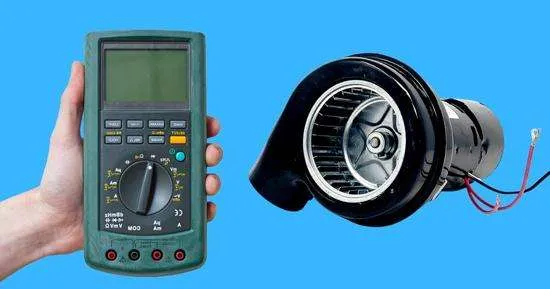A blower motor is an essential component of your HVAC system that rotates the fan to spread air(hot or cold) in your entire room or car. A blower motor is mainly used in furnaces, air conditioners, and heaters for hot and cold air circulation in home and vehicle conditioning systems. In this lesson, you’ll learn how to test the blower motor with a multimeter.
But first, discover the signs of a faulty blower motor:
Signs of a bad blower motor
- Poor(weak) or no air flow from vents.
- More electrical consumption and heavy bills.
- The blower overheats and smells.
- If the motor resistor is faulty, there may be a single-speed airflow.
Table of Contents
ToggleHow to test the blower motor with a multimeter
To test the AC blower motor, check the voltage when installed in the vehicle or connected to a battery.
- Set the multimeter to DC voltage at 20V or higher range.
- Make sure that the motor is connected to a battery.
- Now connect the red probe to the red wire in the connector and the black probe to the black wire in the motor connector.
- If your blower motor is fine, your multimeter should read around 12-12.6 Volts (equal to the battery’s voltage).
Now disconnect the blower motor from the battery and test the resistance:
- By setting your multimeter to resistance.
- Connect both probes to both terminals in HVAC Blower Motor Connector.
- A fine blower motor should have around 0-.5 ohms.
Below we’ve explained step-by-step testing.
Test 1: Test voltage in the blower motor
By testing the voltage of the blower motor with a multimeter, we’ll determine if the blower is getting enough voltage or not.
- Connect your blower motor to a battery or connect it inside the vehicle.
- When the vehicle is in the RUN or START position, insert the red probe inside the red wire in the connector.
- Connect the black probe to the black wire in the blower motor connector or attach it to the negative battery terminal.
- If there is no space for multimeter probes in the connector, connect a thin metal pin at both probes and then insert them and attach them to the connector terminals.
- If your multimeter reads maximum voltage (around the battery’s voltage), such as 12-12.6V, your blower motor is fine.
- Now change, the AC’s speed and fan rotation’s speed will change, and the battery voltage will also vary on the multimeter. It indicates that your blower motor is functioning in every condition.
- If the multimeter reads negative voltage, it means that you have connected wires in opposite directions.
Test 2: Test resistance in the blower motor
First, we’ll test continuity in the blower motor wiring terminals in the connector.
- Set your multimeter to the resistance symbol (Ω).
- Connect the red and black probes inside the blower motor input connector terminals. You can attach probes in any direction, as resistance and continuity are non-directional.
- HVAC Blower Motor Connector is a plug attached at the ends of motor input wires that connects the blower motor to other components, such as the battery.
- If your blower motor is fine, your multimeter should read around 0-.5 ohms in the motor input terminals. Too high or OL (open loop or circuit) means the wires are loose or broken.
How to test the blower motor resistor with a multimeter?
The Blower motor resistor will control the increase and decrease of voltage that results in speed variation of the fan.
First of all, locate the resistor of the blower motor. Visually inspect damage, corrosion, or overheating.
Then set your multimeter to ohms. Connect one probe to the common terminal in the resistor. Attach the second probe to the other terminal in the resistor.
Compare all multimeter readings with the ideal range of your motor blower model. You can find the ideal resistance range of your resistor in the manufacturer’s manual.
If the multimeter reads OL(open loop) in any reading, then that terminal is damaged, and there is a broken current path.
How to bench test the blower motor?
Bench testing means testing a component after removing it from a vehicle or appliance. We’ll connect the blower motor’s input wires to a battery and checks the fan performance.
- Remove the blower from a vehicle to do a bench test on your blower motor. Visually inspect for damage or corrosion in the motor.
- Attach two alligator clips to the terminals inside the blower motor plug. Make sure that both terminals don’t get in contact.
- Take a battery (such as 12V) and connect its positive and negative terminals to the terminals in the blower motor plug.
- Your blower motor fan should rotate at maximum speed when the connection is complete. If the blower motor is faulty, then the fan will rotate slowly.
This is how you bench-test a blower motor.
How to test a furnace blower motor?
First, inspect the motor’s windings and test the capacitor with a multimeter.
Measure resistance between all furnace blower motor wires and note down the color combination of each testing wire and their ohm reading. Compare the multimeter reading with the ideal range on the manual.
How many ohms should a blower motor have?
A blower motor connector terminal should have minimum resistance between 0-.5 ohms.
Conclusion
Everyone needs a functional cooling or heating system to face challenging weather. The blower motor is the main component of an HVAC system that controls the fan, its speed, and air circulation. A faulty blower motor can be identified with typical signs and using a multimeter.
So we have to check the resistance between the blower motor terminals and the voltage your motor consumes.
Follow the complete step-by-step to test your blower motor quickly with a multimeter.
Related Guides:






